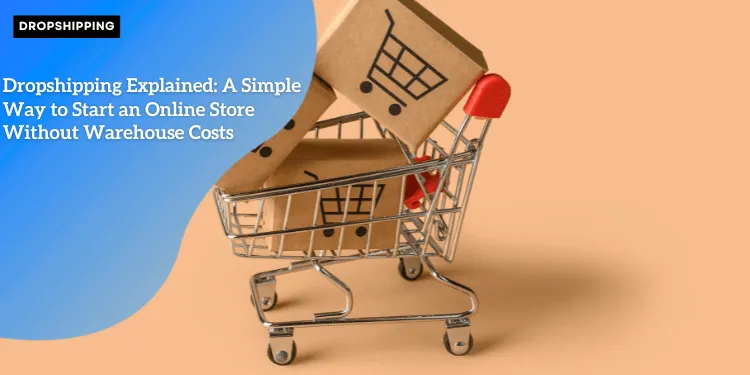Dropshipping Explained: A Simple Way to Start an Online Store Without Warehouse Costs

Anúncios
Dropshipping is a retail fulfillment method where a store doesn’t keep the products it sells in stock.
Instead, when a store sells a product, it purchases the item from a third party and has it shipped directly to the customer.
As a result, the seller doesn’t have to handle the product directly.
This revolutionary approach helps eliminate many traditional retail challenges like buying, storing, and shipping inventory, making it a favored entry point for many new entrepreneurs.
Anúncios
 Dropshipping Explained
Dropshipping Explained
How Orders Are Processed and Fulfilled
The dropshipping process begins when a store receives an order.
Rather than taking items from its own stock, the store forwards the order details to the dropshipping supplier.
The supplier then takes charge of storing, packaging, and shipping the products directly to the customer.
Anúncios
This seamless process allows the store owner to devote more time to other critical business activities, such as marketing and design, without worrying about the complexities of logistics and inventory.
Industry Size and Growing Popularity
Dropshipping is a significant player in the ecommerce industry, contributing more than $370 billion in annual sales.
Its rising popularity can be attributed to its simplicity and the relatively low upfront costs required to start a business.
By removing the need for large inventories and storage facilities, dropshipping lowers the entry barrier for aspiring entrepreneurs, enabling them to focus on customer acquisition and business growth.
Looking at its current trends, it’s clear that dropshipping is not just a fad but a mainstay in the ecommerce landscape, making it a compelling option for individuals looking to break into online retailing.
As we continue to explore dropshipping, the next step is to understand its inner workings, particularly how suppliers fit into the puzzle and fulfill orders.
How Dropshipping Works
Step-by-Step Breakdown of the Order Fulfillment Process
Dropshipping operates through a series of straightforward steps that make inventory management a non-issue for store owners.
Here’s how the process unfolds:
| Step | Description |
|---|---|
| 🛒 Customer Places Order | A customer visits your online store and places an order for a product. |
| ➡️ Order Forwarded to Supplier | You forward the order to your dropshipping supplier. This process can be automated through e-commerce platforms. |
| 🔧 Order Processed by Supplier | The supplier processes the order, including retrieving the product and packaging it for shipment. |
| 🚚 Product Shipped to Customer | The supplier ships the product directly to the customer using the provided shipping information. |
| 📦 Customer Receives Product | The customer receives the product, typically with packaging that features your store’s branding. |
This streamlined process means store owners can prioritize other important aspects of their business, such as marketing and customer service.
Role of Suppliers in Storing and Shipping Products
Suppliers play a pivotal role in the dropshipping model by owning and managing the inventory.
They store products, handle order processing, and manage shipping logistics.
This alleviates the need for store owners to worry about warehousing and fulfillment complexities.
- 🏢 Storage: Suppliers maintain inventory in their warehouses, ensuring that the products are readily available when an order is placed.
- 📦 Packaging: Suppliers handle all packaging, often customizing it to reflect the store owner’s brand.
- 🚚 Shipping: Once packaged, suppliers manage the shipping process, ensuring timely and accurate delivery to customers.s.
This division of responsibilities allows store owners to run their businesses without the headache of physical inventory management.
Description of the Relationship Between Store Owner, Supplier, and Customer
The relationship in the dropshipping ecosystem is a triad involving the store owner, supplier, and customer, each with distinct roles.
- 🛒 Store Owner: The store owner is the face of the brand, responsible for maintaining the online store, marketing, and providing customer service.
- 📦 Supplier: The supplier acts as the backbone of the operation by managing inventory and fulfilling orders. They ensure products are in stock and ready to ship.
- 👥 Customer: The customer engages with the store owner’s brand, placing orders which are then fulfilled by the supplier..
This collaborative dynamic ensures a simplified operational structure, allowing each party to focus on their primary activities.
As a result, store owners can build strong brands without the complexities of traditional retail operations.
This comprehensive understanding of how dropshipping works gives you a solid foundation to appreciate the pivotal role suppliers play in this retail model.
Moving forward, you’ll need to delve deeper into the responsibilities of being a seller of record and maintaining successful customer relationships.
Understanding Dropshipping Suppliers
Dropshipping suppliers are crucial to the success of a dropshipping business.
They take on the responsibility of storing, packaging, and shipping products, allowing store owners to focus on other aspects like marketing and customer service.
In this chapter, we will look at different types of suppliers and their roles in the dropshipping process.
Different Types of Suppliers
There are various types of dropshipping suppliers, each with unique advantages:
- 👤 Individual Suppliers: Small businesses or individual manufacturers who produce or source products on a smaller scale. These suppliers often provide more personalized service and may offer exclusive products.
- 🌐 Platforms like AliExpress: A platform that connects numerous sellers to online retailers. AliExpress is popular for its vast product range and easy-to-use interface, which simplifies the process of finding and working with multiple suppliers.
- 🏭 Manufacturers: Companies that produce goods in large quantities. Working directly with manufacturers can lead to lower costs per unit and more control over product quality.
- 📦 Wholesalers: Distributors who purchase products in bulk from manufacturers and sell them to retailers. Wholesalers can offer competitive prices and a wide selection of products.
Role of Manufacturers and Wholesalers
Manufacturers and wholesalers play a pivotal role in the dropshipping model:
- 🏭 Manufacturers: These suppliers create the products from raw materials. Partnering directly with manufacturers can reduce costs and give better control over the product’s quality and specifications.
- 📦 Wholesalers: They buy products in large quantities from manufacturers and store them until a retailer places an order. Wholesalers often provide a diverse inventory and can offer faster shipping times due to their large stock.
Key Responsibilities of Suppliers in the Fulfillment Process
Suppliers hold several critical responsibilities to ensure smooth operations in a dropshipping business:
- 📦 Storing Products: Suppliers maintain the inventory, relieving store owners of the requirement to hold physical stock.
- 🎁 Packaging: Once a store owner forwards a customer’s order, the supplier packages the product. Packaging often includes the retailer’s branding information to maintain consistency.
- 🚚 Shipping: The supplier ships the product directly to the customer, managing logistics and ensuring timely delivery.
Understanding the different types of suppliers and their roles helps store owners make informed decisions and select the best partners for their dropshipping business. These relationships form the backbone of dropshipping success, ensuring efficiency and customer satisfaction.
Seller of Record Responsibilities
Legal and Financial Obligations
As a seller of record in the dropshipping model, you carry the essential legal and financial responsibilities for every transaction made through your store.
This involves setting prices for your products, collecting payments, and ensuring you’re compliant with local laws, including tax obligations.
Even though your supplier handles product storage and shipping, you must ensure that your business operates within the legal frameworks of your target market.
It’s crucial to accurately account for taxes, which can vary significantly depending on the geographic locations involved.
Being the primary point of contact for your customers, you’re responsible for managing customer service, handling returns, and processing refunds.
When a customer has a question or an issue, they will reach out to you, not the dropshipping supplier.
This means you need to be proactive in addressing queries and providing support.
If a customer wants to return a product, you will coordinate with the supplier to facilitate the return process.
This may involve issuing return shipping labels, providing customers with return instructions, and ensuring that refunds are processed efficiently.
Managing returns and refunds effectively helps maintain customer satisfaction and trust in your brand.
Managing Pricing and Payment Collection Including Taxes
Setting the right prices for your products is another critical responsibility.
You need to consider your supplier’s costs, shipping fees, and your desired profit margins.
Competitive pricing can help attract more customers, but it’s essential to ensure that prices cover all expenses while still allowing for a reasonable profit.
Collecting payments is straightforward with modern e-commerce platforms, but you must also manage the financial aspects, including processing fees from payment gateways.
Additionally, you must calculate and remit sales taxes accurately.
Compliance with tax laws ensures that you avoid legal issues and maintain the integrity of your business.
Fulfilling these responsibilities enables you to build a reputable and customer-friendly dropshipping store, balancing the benefits of low overhead costs with these operational challenges.
Benefits and Trade-offs
Low Overhead Costs and Minimal Inventory Management
One of the standout advantages of dropshipping is the incredibly low overhead costs.
Traditionally, retail businesses incur significant expenses on inventory, warehousing, and logistics.
Dropshipping eliminates the need for such investments since store owners don’t purchase products upfront or maintain inventory.
Instead, when an order is placed, it is forwarded to a supplier who handles storage and shipping.
This significantly minimizes the financial risk associated with unsold inventory and storage expenses.
Ability to Focus on Marketing and Branding
With the heavy lifting of inventory management off your shoulders, dropshipping allows you to concentrate on what truly matters for business growth: marketing and branding.
This freedom enables you to craft compelling brand stories, design attractive marketing campaigns, and engage with customers without getting bogged down by operational hassles.
With suppliers taking care of fulfillment, your primary focus can shift to scaling your business through innovative marketing strategies and strong brand identity.
Limited Control Over Customer Experience and Potential Challenges
However, dropshipping does come with trade-offs, most notably the limited control over the customer experience.
Since suppliers are responsible for storing, packaging, and shipping products, any issues in these areas can adversely impact customer satisfaction.
Delays in shipping, errors in order fulfillment, or substandard product quality can lead to negative feedback and hurt your store’s reputation.
Additionally, coordinating returns and refunds can be cumbersome due to the involvement of third-party suppliers.
As a store owner, it’s crucial to establish clear communication channels with suppliers to mitigate these challenges.
Efficiently balancing these benefits and trade-offs requires a keen focus on supplier management and customer service, ensuring a smooth operation and high satisfaction for your buyers.
